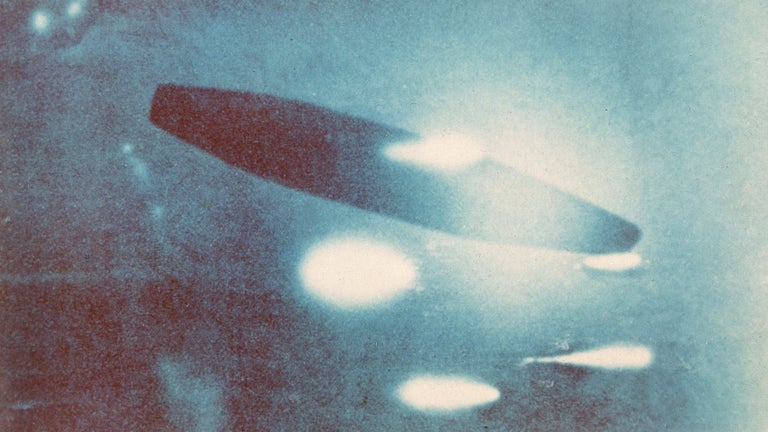In recent months, a storm has been brewing in the world of UFO research. At its center is an alleged secret Pentagon program known as “Immaculate Constellation.” This project, if it exists, could reshape our understanding of how the U.S. government approaches the study of Unidentified Anomalous Phenomena (UAPs), commonly called UFOs. But what do we actually know about it? Let’s dive in and separate the facts from the speculation.

The story broke when independent journalist Michael Shellenberger published a series of articles and social media posts about a whistleblower report provided to Congress. This report, according to Shellenberger, detailed a highly classified program dedicated to investigating UAPs. The program, dubbed “Immaculate Constellation,” is described as an Unacknowledged Special Access Program (USAP) allegedly created in 2017.
Now, USAPs are no joke. They’re among the most secretive projects in the U.S. government, often operating with limited oversight and strict information compartmentalization. If Immaculate Constellation is real, it’s playing in the big leagues of government secrecy.
So what’s this program supposed to do? According to the reports, it serves as a central hub for collecting and analyzing UAP incidents reported by U.S. military personnel. Imagine a massive database filled with accounts of weird stuff seen in the skies by pilots, sailors, and other military folks. We’re talking orbs surrounding military aircraft, mysterious spheres observed by Navy crews, and other phenomena that make you scratch your head and go “huh?”
The whistleblower report that Shellenberger cites is at the heart of these revelations. It allegedly provides detailed information about how Immaculate Constellation is structured and what it does. But here’s the thing – we don’t know who this whistleblower is or what role they played. That makes it tough to independently verify their claims.
One of the most eyebrow-raising claims in the report is the mention of “alien reproduction vehicles” (ARVs) supposedly secured within the program. Now, if true, this would be huge. We’re talking potential non-human technology in the hands of the U.S. government. But let’s pump the brakes here – this claim is highly controversial and, so far, completely unverified.
When asked about all this, the Department of Defense did what you’d expect – they denied it. They said, nope, no such program exists. Now, that’s not unusual when it comes to classified programs. The government’s standard response to questions about secret projects is usually
“we can neither confirm nor deny”
So a flat-out denial is interesting, but it doesn’t necessarily mean the program doesn’t exist.
Shellenberger claims he’s got multiple sources backing up this story, not just the initial whistleblower. That’s good – multiple sources lend more credibility. But again, we don’t know who these sources are or what positions they hold. Without that information, it’s hard to gauge how reliable their claims might be.
Another interesting tidbit is that the program is allegedly run out of the Secretary of Defense’s office. If true, that would suggest this isn’t some low-level operation, but something with high-level oversight and importance.

All of this has caught the attention of some folks in Washington. There have been calls for congressional hearings and further investigation. Some lawmakers are concerned about the potential existence of a highly classified program operating with limited oversight. This isn’t coming out of nowhere – in recent years, there’s been an uptick in official acknowledgment of UAP incidents, including the release of those famous Navy videos and the establishment of the All-domain Anomaly Resolution Office (AARO) to investigate such phenomena.
To really understand what Immaculate Constellation might mean, we need to look at the history of U.S. government UFO investigations. Back in the 1950s and 60s, we had Project Blue Book. More recently, there was the Advanced Aerospace Threat Identification Program (AATIP) in the 2000s. If Immaculate Constellation exists as described, it would be a major step up from these previous efforts. The level of secrecy and resources allegedly devoted to it suggest the government might be taking this stuff way more seriously than they’ve publicly admitted.
Now, investigating claims about super-secret programs isn’t easy. These things are designed to be hard to confirm or deny. Even people within the government might not know about them due to strict need-to-know protocols. This creates a frustrating situation where if the program exists, those who know about it probably can’t talk about it. And if it doesn’t exist, well, how do you prove something doesn’t exist beyond saying “it doesn’t exist”?
If the claims about Immaculate Constellation turn out to be true, the implications could be huge. It would suggest that the U.S. government has been taking the UAP phenomenon much more seriously than they’ve let on. The alleged database of incidents could be a goldmine for scientists trying to understand these phenomena.
And let’s not forget about those “alien reproduction vehicles.” If there’s any truth to that claim (and that’s a big if), we’re talking about a potential revolution in our understanding of technology and possibly our place in the universe. But remember, extraordinary claims require extraordinary evidence, and so far, we’re short on hard evidence.

The whole Immaculate Constellation story has definitely reignited public interest in UAPs and government secrecy. This comes at a time when talking about UAPs has become more mainstream. Major news outlets are covering the topic more seriously than they used to, and it’s not just relegated to late-night radio shows anymore.
In the scientific community, there’s been a growing push for rigorous, unbiased study of UAP incidents. Take the Galileo Project, led by Harvard astronomer Avi Loeb. They’re trying to bring serious scientific methodology to the study of unexplained aerial phenomena. If a program like Immaculate Constellation exists, the data it’s collected could be invaluable for this kind of scientific research.
But let’s not get ahead of ourselves. While the claims about Immaculate Constellation are intriguing, we need to consider alternative explanations. Some skeptics have suggested that the “whistleblower” information could be part of a disinformation campaign, either by foreign actors or even elements within the U.S. government itself. Others think the claims might be misinterpretations of more mundane classified programs dealing with advanced aerospace technology.
As of now, the existence of Project Immaculate Constellation remains unconfirmed. Journalists, researchers, and possibly government investigators are digging deeper into the claims. We might see more information come to light in the coming months, either through further leaks, official statements, or possibly congressional hearings.

One thing’s for sure – Project Immaculate Constellation, whether real or not, has already had an impact. It’s stimulated discussion about government transparency, the nature of UAPs, and the possibilities of advanced technology.
The truth about Immaculate Constellation – and the broader questions it raises about UAPs – may not be immediately forthcoming. But the pursuit of that truth continues to captivate imaginations and drive serious inquiry into one of the most enduring mysteries of our time.
So where does this leave us? Well, we’re in a bit of a holding pattern. We’ve got some intriguing claims, but not much in the way of hard evidence. The government denies the program exists, but then again, they would, wouldn’t they? Even if it did exist.
What we do know is that the U.S. government has taken an increased interest in UAPs in recent years. The creation of the AARO and the release of the UAP videos show a shift towards more openness on the topic. But how far does that openness extend? That’s the million-dollar question.
The claims about Immaculate Constellation, if true, would suggest that there’s a lot more going on behind the scenes than we’ve been told. But without more concrete evidence, it’s hard to draw any firm conclusions.
One thing that’s clear is that this story has touched a nerve. It’s tapped into a long-standing fascination with the unknown and a deep-seated suspicion of government secrecy. People want answers, and stories like this feed into that desire.
The truth is out there, as they say. But finding it might take time, patience, and a whole lot of hard work. The Immaculate Constellation story is just one piece of a much larger puzzle. As we continue to investigate and ask questions, we might just find that the reality is even more interesting than the rumors.

Project Immaculate Constellation: Congressional Hearings and Ongoing Investigations
In recent weeks, the topic of Unidentified Anomalous Phenomena (UAPs), commonly referred to as UFOs, has gained significant traction in the halls of Congress. This renewed interest is largely fueled by the emergence of a secret Pentagon program known as “Immaculate Constellation.” As the government grapples with the implications of UAP sightings, congressional hearings have been convened to investigate the claims surrounding this program and to seek greater transparency from military and intelligence agencies.
Recent Congressional Hearings

The growing interest in UAPs culminated in a series of congressional hearings aimed at uncovering the truth behind these phenomena. The most recent hearing was held by the House Oversight Committee, which focused on exposing potential secrets related to UAP research programs conducted by the U.S. government.
During these hearings, various witnesses, including former military officials, provided testimony about their experiences with UAP sightings. They expressed concerns that the government may know more about these phenomena than it has publicly acknowledged. The testimony included accounts of unexplained aerial encounters and discussions about the need for a more transparent reporting process for military personnel who experience such phenomena.
One notable moment from the hearing involved David Grusch, a former U.S. intelligence official, who asserted that he is “absolutely” certain that the federal government is in possession of UAPs. He claimed to have conducted interviews with numerous witnesses over several years and stated that there exists a multi-decade program focused on collecting and reverse-engineering crashed UAPs.
Calls for Transparency

The hearings have sparked bipartisan calls for increased transparency regarding UAP investigations. Lawmakers have expressed frustration over what they perceive as a lack of accountability from the Pentagon and intelligence agencies. Some representatives have argued that Americans deserve to know more about what their government knows regarding UAPs and potential threats posed by unidentified aerial phenomena.
Former Navy pilot Ryan Graves testified about the stigma associated with reporting UAP sightings within the military. He emphasized that many pilots fear professional repercussions if they come forward with their experiences. This stigma can deter individuals from reporting encounters, leading to a lack of comprehensive data on UAP incidents.
The hearings also highlighted the need for clear channels through which military personnel can report UAP sightings without fear of ridicule or retribution. Lawmakers have urged the establishment of a safe and transparent reporting process for both military and commercial pilots.
Implications of Immaculate Constellation
If Project Immaculate Constellation exists as described, its implications could be profound. It would suggest that the U.S. government has been taking the phenomenon of UAPs much more seriously than previously acknowledged. The existence of a centralized database of incidents could provide valuable insights into these unexplained occurrences.
Moreover, if claims about ARVs are substantiated, it could indicate that advanced technology beyond our current understanding may exist within government facilities. This raises questions about national security and technological advancements that could impact various sectors.
However, skepticism remains regarding these claims. The Department of Defense has denied any knowledge of such programs or technologies related to extraterrestrial origins. Critics argue that extraordinary claims require extraordinary evidence, and thus far, much of what has been presented is anecdotal or speculative.
The Road Ahead
As investigations into Project Immaculate Constellation continue, it remains to be seen what additional information will emerge from congressional hearings and whistleblower testimonies. The ongoing discussions surrounding UAPs have prompted increased public interest in government transparency and accountability regarding these phenomena.
Lawmakers are expected to push for further investigations into both Immaculate Constellation and other potential UAP-related programs within the government. The outcome of these inquiries could lead to significant changes in how such phenomena are studied and reported in the future.










